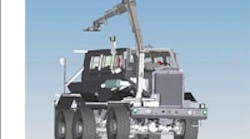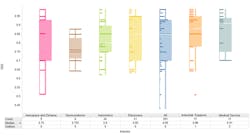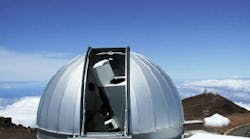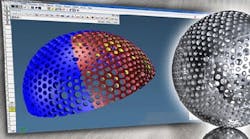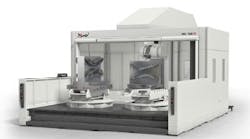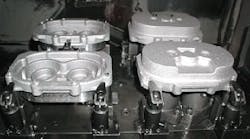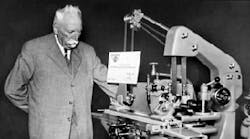The U.S Department of Defense is demanding more Mine Resistant Ambush Protected vehicles (MRAPs). Manufacturers are answering that call for increased production while they turn out improved versions of the vehicles. MRAPs provide greater protection for U.S. military personnel in theaters of war in Iraq and Afghanistan.
Three manufacturers that currently build MRAPs — Force Protection Industries, Inc. near Charleston, S.C. (www.forceprotection.net), International Military Vehicles LLC (part of International Truck’s Navistar Division) in Warrenville, Ill. (www.internationaldelivers.com), and BAE Systems, Inc. in Rockville, Maryland (www.baesystems.com) — follow the automotive production model of concentrating on design and assembly in-house while outsourcing part production. Because the work is for the Department of Defense, the outsourcing of parts for these vehicles goes to U.S. suppliers, giving U.S. machine shops opportunities to earn money while they help to keep troops safe.
MRAPs are a relatively new type of vehicle. As the war in Iraq shifted from conventional to guerrilla warfare, the need for specialized armored vehicles shifted from tanks and traditional armored personnel carriers to these heavily reinforced personnel carriers. Military troops can’t patrol an urban neighborhood effectively if they are buttoned up in vehicles such as an M1 Abrams tank. They need patrol vehicles that provide them good visibility of what is happening around them while offering protection from enemy fire.
At the outset of the war in Iraq the High Mobility Multipurpose Wheeled Vehicle (the Humvee) was the primary vehicle used for urban partrols. The Humvee is the original, military version of the Hummer, the civilian model of the High Mobility Multipurpose Wheeled Vehicle that such high-profile cebrities as California’s Governor, Arnold Schwartzenegger drives.
A fully-armored Humvee offers protection from gunfire while giving its occupants clear views of the surrounding area, and as the war went from invasion to occupation, the Humvee became the preferred troop carrier of choice for U.S. Army and Marine commanders.
Unfortunately, the Humvee has a design characteristic that guerrilla insurgents began to attack.
The Humvee floor is flat, and was found to be vulnerable. If a land mine is detonated beneath the vehicle, the energy from the blast can be directed into its cabin with fatal results. It is that Humvee underbelly that the roadside bombs – improvised explosive devices (IEDs) that insurgents in Iraq and Afghanistan try to get to, and in many cases, succeeded. And, as the guerrillas changed their tactics, the U.S. military changed its tactics too.
The U.S. military’s response was a new type of patrol vehicle, the MRAP.
The U.S. Marine Corps plans to replace all Humvees in the Iraq and Afghanistan combat zones with MRAP vehicles. MRAPs are considered an “urgent need” for the military, and U.S. Defense Secretary Robert Gates said that acquisition of the vehicles has become the highest priority for the Department of Defense. The U.S. Government set aside $1.1 billion dollars to acquire these vehicles in fiscal 2007 and, legislation to continue—and perhaps increase— that funding for 2008 is pending in Congress.
The Department of Defense recently said that it could require more than 18,000 MRAP vehicles, at a cost of nearly $20 billion.
The reason that MRAPs have become the preferred vehicle is because they have a “V” shaped underbody that helps to deflect blasts from land mines or improvised explosive devices away from the vehicle’s interior. That armored underbody keeps the vehicle’s occupants safe and the vehicle intact.
The basic design is not new. It was first used by South Africa in the 1970s and has been used by other nations since then. The U.S. military had no need for this type of vehicle until the Iraq war and now there is an urgent demand to deploy MRAPs as quickly and as extensively as possible.
There are currently three categories of MRAPs based on vehicle weight class and size. Category 1 is the Mine Resistant Utility Vehicle (MRUV), a smaller, lighter vehicle that is designed primarily for urban operations. Typical vehicles in this class are the Force Protection Cougar H 4X4, International MaxxPro, and BAE RG- 31 and RG-33.
Category 2 includes the Joint Explosive Ordnance Disposal (EOD) and Rapid Response Vehicle (JERR V) vehicles that are used for troop transportation and ambulances, as explosive ordnance disposal vehicles and as lead vehicles in convoys. The Force Protection Cougar HE 6x6, the BAE RG-33L 6x6, and the International MaxxPro XL are models in this category.
Category 3 comprises the largest MRAP vehilces, including the Buffalo made by Force Protection. The Buffalo is the first MRAP to become a movie star: Is was one of the vehicles used in recently released movie “Transformers,” made by the Dreamworks Studio.
Even as the Department of Defense issues contracts to build more MRAPs, the designs for the vehicles are changing.
In July, the Marine Corps issued an MRAP II presolicitation for vehicles that provide more protection than the current MRAP designs. Current designs are not always effective against Explosively Formed Penetrators (EFP) that use shaped charges to project a hypervelocity jet of metal that is capable of cutting through thick armor. The use of explosively formed penetrators has increased in the conflicts in Iraq and Afghanistan, even as the wide-spread deployment of the current models of MRAPs has helped to reduce casualties by improvised explosive devices as much as 80 percent. The U.S. Marine Corps expects that the next generation of MRAPs will continue to reduce casualties.
Force Protection, Inc. assembles its Buffalo and Cougar models at its South Carolina facility and is opening a new facility in Roxboro, North Carolina to assemble the its newest design, the Cheetah.
Tommy Pruit, spokesman for Force Protection, said all of his company’s machining is outsourced.
Force protection focuses on design, development and final assembly. Suppliers interested in working with Force Protection can find information about gaining contracts by going to the company’s website, (www.forceprotection.net). Information on becoming a supplier can be found by clicking on the “Contacts” button in the menu at the top of the page, then selecting “Supplier Contacts”. Interested suppliers can choose category from the drop-down menu, then use the link provided to send an initial email to the company.
Pruit said his company has enough suppliers at the moment, but added that Force Protection may need additional suppliers as it increases production to meet the increasing demand for its vehicles. He said now would be a good time for a new supplier to begin the qualification process.
International Military Vehicles LLC is part of International Truck’s Navistar Division. While the company’s headquarters is in Warrenville, Ill., its fabrication and assembly is done in several widely scattered locations.
Engines are built in the company’s Melrose Park, Ill. facility. Chasses are fabricated in its Garland, Texas facility. Subassemblies and other parts are shipped to the company’s West Point, Miss. facility for final assembly.
As with Force Protection, the best way to approach International is through its website at(www.internationaldelivers.com). Information for the company’s “Supplier Network” is provided as an option under the “Corporate Info” button on the left side of its home page.. The Supplier Network option will take you to a page that has information for new and current suppliers. That page includes news, requirements for doing business with International, and the company’s terms and conditions, and contacts. This information is available for working with International Truck on contracts for its military and other vehicles.
Contacting BAE Systems, Inc. is not quite as easy as contacting the other companies.
The company is headquartered in Rockville, Md., and is the U.S. subsidiary of BAE Systems, Plc., a global aerospace and defense manufacturer based in the United Kingdom.
BAE makes products for a wide range of applications from submarines and naval surface fleet to land armaments and aircraft.
To find out how to do business with the company, go to its corporate website at (www.baesystems.com). Once there, select the “About Us” option and then choose the “Supplier Centre” button on the left side of the page. On the Supplier Centre page choose the “Supply Chain” link on the right side of the page. On the Supply Chain page select “Contact Us” on the bottom of the left side. After all that you will get telephone numbers and email addresses for the company’s contacts in London.
It is more than a pun to say that the market for MRAPs is exploding. More than 6,000 of these vehicles are scheduled to be built this year, and current estimates say that more than 18,000 of these vehicles will be built over the next few years. Tens of billions of dollars will be spent by the Pentagon over the next few years as it rearms and reequips the U.S. military, and MRAPs are a big part of that rearmament. Now is the time to start looking for contracts to machine parts for those vehicles.
